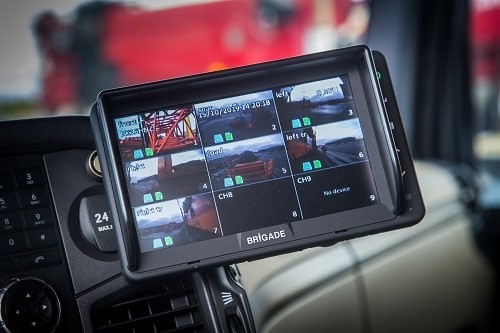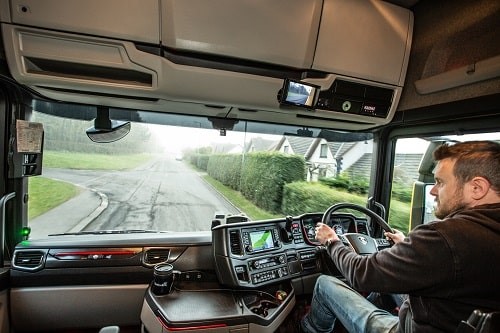The technology that can be fitted to heavy goods vehicles to reduce the risk they pose to vulnerable road users is becoming increasingly sophisticated, and also offers other benefits, such as helping businesses defend themselves from fraudulent insurance claims in the event of a collision in which their driver are blameless.
Features
Fleet safety technology: a wealth of options
Brigade has been at the forefront of road safety for over 40 years and sells aftermarket solutions for heavy goods vehicles and mobile plant – including ultrasonic obstacle detection, white sound reversing alarms, camera systems, and live digital recording devices.
The company believes HGV drivers need a combination of direct and indirect vision and other cutting-edge safety equipment, such as sensor and audio technology, for optimal safety.
Innovation in road safety technology
Over the past 20 years, the pedestrian casualty rates in the UK have plummeted thanks largely to advances in road safety technology.
 Brigade believes HGV drivers need a combination of direct and indirect vision and other cutting-edge safety equipment. Photograph: Brigade Electronics
Brigade believes HGV drivers need a combination of direct and indirect vision and other cutting-edge safety equipment. Photograph: Brigade Electronics
Between 2004 and 2021 fatalities decreased by 46 per cent and serious injuries fell by 51 per cent, according to UK government figures.
But every death and injury is one too many. In fact, in 2021, 361 pedestrians were killed in Great Britain, while 5,032 were reported to be seriously injured and 11,261 were slightly injured. Heavy goods vehicles pose a disproportionate risk to vulnerable road users (VRUs) such as pedestrians, cyclists, and those riding scooters.
The need for further advances in road safety technology is also laid bare by the 10 per cent rise in pedestrian traffic in the last two decades, a rise that shows no signs of slowing down.
The sad fact is the majority of these deaths and injuries are preventable and there is more we can do – fortunately, advances in road safety technology present a solution.
Technological vision
A key ally in the drive to reduce accidents is the latest generation of road safety cameras.
Vehicle-mounted cameras can now detect pedestrians using artificial intelligence (AI) and state-of-the-art machine learning.
The cameras are a new generation of active blind-spot detection that recognises humans using AI and then warns the driver visually and/or audibly when a person is detected.
The operating system used in the cameras is ‘trained’ to recognise people over hundreds of thousands of hours.
 The cameras are a new generation of active blind-spot detection that recognises humans using AI and then warns the driver visually and/or audibly when a person is detected. Photograph: Brigade Electronics
The cameras are a new generation of active blind-spot detection that recognises humans using AI and then warns the driver visually and/or audibly when a person is detected. Photograph: Brigade Electronics
These systems use a HD camera at the front and rear of the vehicle. The front camera has a narrow angle at the front to prevent people on the pavement from setting it off but has a wider angle at the back where visibility is lowest. The detection range stretches from the very front of the vehicle to three metres out and the driver can see what triggered the alarm through a monitor.
The system alerts lorry drivers to potential dangers, such as a VRU in its blind spot, but will not trigger if it detects a static object, such as road furniture, so drivers don’t become numb to constant false alerts.
It has an exceptionally quick reaction time – for all intents and purposes instantaneous – when it identifies VRUs.
The minicomputer built into the camera units uses an ongoing process of machine learning to continually improve detection rates using a state-of-the-art algorithm.
The effectiveness of cameras is laid bare by a survey of drivers, fleet managers, and other industry professionals undertaken by Brigade.
It found more than half (56 per cent) say the tech improved driver behaviour, and 47 per cent of those surveyed said incident reports had decreased after installation.
The research also found 29 per cent said personal injury claims had dropped, while 32 per cent saw a reduction in insurance costs.
Insurance fraud
Cameras can also help fleet managers protect drivers from the rising number of ‘cash for crash’ scams.
The Insurance Fraud Bureau (IFB) says criminal gangs are spreading out from big cities and targeting people in towns and villages with false accident claims, usually involving fraudsters slamming on their brakes at busy junctions and roundabouts so the driver behind cannot stop in time.
However, businesses with fleets can protect themselves using dashboard cameras – dashcams – and mobile digital recording (MDR) to gather digital evidence to protect themselves.
A lack of solid evidence can often mean companies automatically accept liability, costing businesses across the UK millions each year, but dashcams and MDR can provide vital evidence to prove the driver’s innocence and are therefore not financially liable.
 Emily Hardy, UK marketing manager at Brigade Electronics plc
Emily Hardy, UK marketing manager at Brigade Electronics plc
Wide-angle HD cameras allow insurance companies and police to easily recognise faces and registration numbers, while supplemental data like location and speed data is stored thanks to MDR.
Having recorded footage where there are conflicting reports of actual events or by being able to prove a staged accident, companies can make major cost savings and support their drivers, who are often the subject of increased scrutiny after an incident.
Cameras can also help provide evidence in cases of vandalism and attacks on drivers.
Case study
A truck equipped with a 4G-enabled mobile digital recording (MDR) was involved in a head-on collision. The fleet manager remotely accessed the data before the emergency services arrived at the scene and was able to check the speed and positioning of the truck.
He was able to watch the vehicle on the wrong side of the road drive straight into the company’s truck.
The footage showed the truck driver was not at fault and allowed the company to reassure him that he was not culpable.
Instant access to the data proved invaluable as the MDR was seized by the police, meaning the company and driver would have had to wait until the hard drive footage could be retrieved and details of the incident could be confirmed.
Sensor safety
Most of the collisions between VRUs and HGVs occur during lorry manoeuvres or at junctions, with the most serious risk to pedestrians and cyclists coming from the largest, heaviest vehicles that seat the driver high up and provide only limited ‘direct vision’ (a driver’s ability to see what is going on outside their cab without using the indirect means of mirrors or cameras).
Obstacle detection using ultrasonic sensors can minimise both vehicle damage and collisions with pedestrians or cyclists – perfect for road-going commercial vehicles operating in confined spaces or manoeuvring at low speeds.
The detection system alerts the driver of obstacles close to the vehicle, whether moving or stationary. An audible and/or visual in-cab warning informs of distance while an optional external speaking alarm can be added to alert cyclists and pedestrians that the vehicle is turning.
Current warning systems – while effective – are not predictive, but merely register the presence of a potential obstacle. This results in false warnings, leading the driver to lack confidence and even ignore the system because they become habituated to the warning signal.
The latest generation of warning systems no longer ‘passively’ detect obstacles, pedestrians and other road users, they ‘actively’ detect them. They constantly gather object detection data such as the speed, direction, acceleration and turning rate of a vehicle using ultrasonic sensors.
The tech also gathers information from the cyclist or other VRU – for example, its speed and distance from the lorry. This data feeds into an algorithm that calculates the risk of a collision with cyclists and/or pedestrians alongside the vehicle.
By creating a predictive system, the technology eliminates false alarms and allows the driver to be confident in the accuracy of the warning.
Some systems also differentiate static objects, like road furniture, from moving objects (i.e. VRUs), and only send audible alerts to the driver when there is a potential risk of collision, thus reducing significantly the number of false positive alarms in the cabin.
Geo-fencing
Road safety technology systems include location tracking so that managers can find their fleet anytime and anywhere.
An exciting component of these systems is geo-fencing capabilities, where managers can identify when vehicles are entering or leaving specific areas, and trigger warnings that instantly notify fleet managers of incidents. Drivers can also send an instant notification in the event of an emergency.
For example, a quarry is situated close to a village that has a bridge over its river. The bridge is prohibited to vehicles over three tonnes yet it is a much shorter journey than the alternative, which takes an extra 15 minutes to reach the main carriageway.
The quarry was hearing reports their tippers were sometimes being driven over the bridge instead of using the permitted route. The fleet was fitted with 4G-enabled MDRs which featured geo-fencing, enabling the fleet manager to receive a notification each time a tipper was driven into the prohibited zone set on the MDR, and allowed action to be taken as necessary.
The geo-fencing eliminated the problem and the drivers subsequently only used the permitted route.
Direct Vision Standard – what operators need to know
On Monday 4 September 2023, the long awaited final Progressive Safe System (PSS) was published by Transport for London (TfL).
In October 2024 the minimum star rating requirement for the Direct Vision Standard (DVS) (a TfL scheme that requires operators of lorries over 12 tonnes gross vehicle weight to obtain a safety permit before entering and operating in most of Greater London), will increase from one to three stars (the DVS star rating measures how much an HGV driver can see directly through their cab windows, an indication or the level of risk to VRUs).
Vehicles that fall short of the three-star rating will need to be equipped with extra safety equipment to obtain a permit. Previously, the permit for extra equipment was called a safe permit. This too is changing and from October 2024 will be known as the Progressive Safe System (PSS). The latest advancements in fleet safety technology will be required, meaning that some operators will need to replace their existing equipment with new, more advanced technology.
Collision avoidance technology
The previous safe permit required obstacle detection systems on the nearside but the Progressive Safe System requires technology that predicts collisions based on the trajectories of the vehicle and the VRU, to calculate if a collision is imminent.
There is also a specified alarm strategy to warn the driver of the severity of the situation. For example, if the vehicle and VRU are travelling in the same direction on a parallel path to each other, they can continue to do so for an infinite time, even if they are in close proximity. This does not constitute an imminent collision and therefore the driver would not need to receive an audible warning. If the VRU was on a collision path with the vehicle, then a more stringent audible and visual warning alarm should be sounded.
The new predictive technology is quite unlike systems that drivers have been familiar with and will require the re-education of those who are familiar with the older VRU detection systems. The specification also requires blind spot information systems to warn the driver if the system is not working correctly.
Sensors at the front
The PSS also requires a sensor system at the front. This was recommended in the safe permit, but not mandatory and so few operators fitted it. The front system requires two alarms – one when the driver detects a VRU when preparing to move off and one when the vehicle detects a VRU as it has begun its forward manoeuvre.
General Safety Regulations
Vehicles that are approved to UNECE Regulation 151 and 159 will be deemed to comply with the side detection and front sensor system, but operators need to understand that there is a difference between Reg 151, 159 and DVS requirements. They have different detection areas. For instance, on the side, Reg 151 allows for a gap of 0.9 metres, whereas DVS requires detection right up to the
side of the vehicle. Similarly, with the front, Reg 159 allows a gap of 0.8 metres, but DVS requires detection right up to the nose of the vehicle. The General Safety Regulations (GSR) refer to the whole vehicle homologation and not at component level. Therefore, a product that meets 151 and 159 Regs may not necessarily meet DVS requirements at aftermarket.
Raising the standard of quality products and professional fitment
The PSS sets out specific test procedures and it is the responsibility of the DVS equipment manufacturer to confirm that products meet the requirements via a ‘sensor functionality statement’. The manufacturer should also provide details on how the products link with other systems and they should not adversely affect any safety-critical aspects or performance of the vehicle. If a product has an e-mark it will meet these requirements.
The document will need to be uploaded by the operator with the photographic evidence. If there are any non-compliance issues identified at a later date, it will be easily identified from the manufacturer used. Fitters will also need to confirm that the sensors fitted to the vehicle are active and fitted in compliance with the technical PSS specification.
For more information see:
brigade-electronics.com
tfl.gov.uk
Emily Hardy is UK marketing manager at Brigade Electronics plc
FEATURES

Sedentary working and how to combat the ‘sitting disease’
By Gavin Bradley, Active Working on 05 April 2024
Prolonged and excessive sitting poses a major risk to our health, but the Get Britain Standing campaign and On Your Feet Britain Day on 25 April are a great way of encouraging workers to sit less and move more.

Company culture and wellbeing: a crucial link
By Bex Moorhouse, Invigorate Spaces on 05 April 2024
Investing in measures to support worker wellbeing will be ineffective unless the company culture genuinely incorporates values like teamwork, involvement, flexibility and innovation.

Office design and culture: happier and healthier staff – or the opposite?
By Guy Osmond, Osmond Ergonomics on 03 April 2024
Applying ergonomic principles to workstation set-ups and ensuring the physical environment supports neurodivergent people are just some of the ways of creating an office where everyone can thrive, but a supportive and positive organisational culture is vital too.


